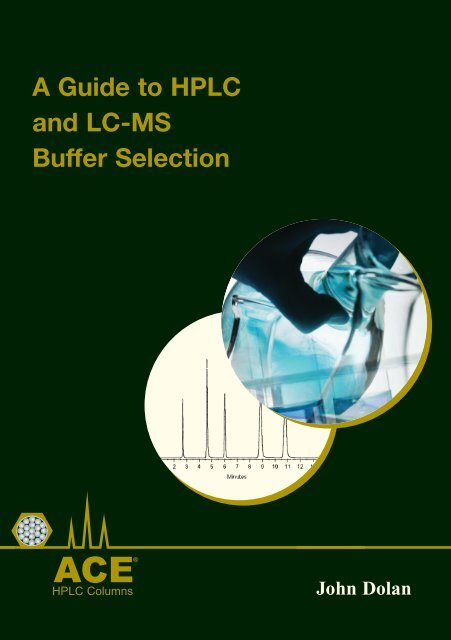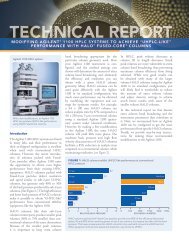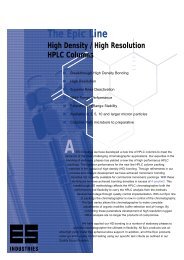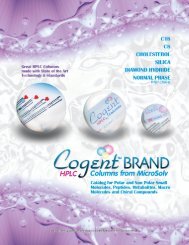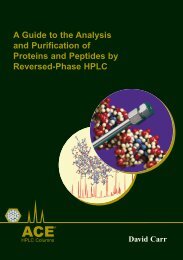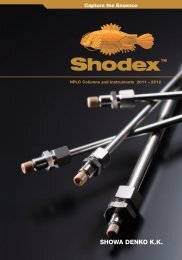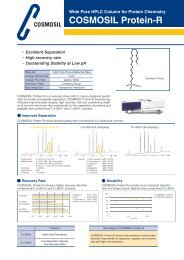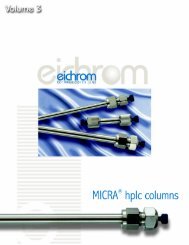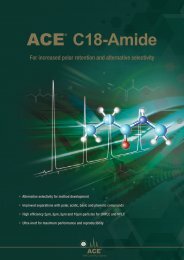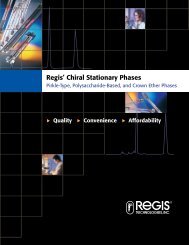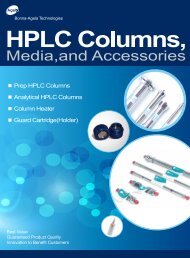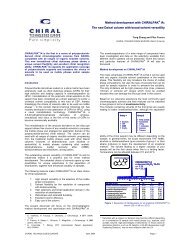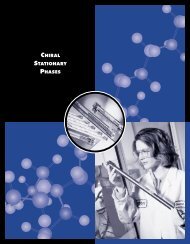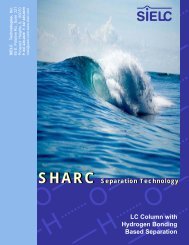A Guide to HPLC & LC-MS Buffer Selection - by John W ... - Hplc.eu
A Guide to HPLC & LC-MS Buffer Selection - by John W ... - Hplc.eu
A Guide to HPLC & LC-MS Buffer Selection - by John W ... - Hplc.eu
You also want an ePaper? Increase the reach of your titles
YUMPU automatically turns print PDFs into web optimized ePapers that Google loves.
A <strong>Guide</strong> <strong>to</strong> <strong>HP<strong>LC</strong></strong><br />
and <strong>LC</strong>-<strong>MS</strong><br />
<strong>Buffer</strong> <strong>Selection</strong><br />
<strong>HP<strong>LC</strong></strong> Columns<br />
<strong>John</strong> Dolan
Your decision has lasting effects.<br />
Choose wisely.<br />
<strong>HP<strong>LC</strong></strong> Columns<br />
Ultra Inert Base-Deactivated <strong>HP<strong>LC</strong></strong> Columns<br />
For Performance, Selectivity<br />
and Guaranteed Reproducibility<br />
ACE performance<br />
guarantee<br />
✓<br />
If ACE does not outperform your existing column (of equivalent phase,<br />
particle size and dimensions), send in your comparative data within 60<br />
days and keep the ACE column FREE OF CHARGE.
Using <strong>Buffer</strong>s with <strong>HP<strong>LC</strong></strong> and <strong>LC</strong>-<strong>MS</strong><br />
Table of Contents<br />
Page<br />
Why Control pH 2<br />
Practical Implications 4<br />
Controlling pH 4<br />
What about <strong>LC</strong>-<strong>MS</strong> 6<br />
Just Interested in Low pH 7<br />
Or High pH 7<br />
How Much 7<br />
Solubility Issues 10<br />
Dilution Effects 11<br />
<strong>Buffer</strong> Preparation 12<br />
Precautions 13<br />
Summary 15<br />
References 16<br />
www.ace-hplc.com
Using <strong>Buffer</strong>s with <strong>HP<strong>LC</strong></strong> and <strong>LC</strong>-<strong>MS</strong><br />
When samples contain ionizable compounds, the mobile phase pH can be one of<br />
the most important variables in the control of retention in a reversed-phase<br />
<strong>HP<strong>LC</strong></strong> (RP-<strong>HP<strong>LC</strong></strong>) separation. However, if it is not controlled properly, pH can<br />
be a source of many problems. Since most compounds analyzed <strong>by</strong> RP-<strong>HP<strong>LC</strong></strong><br />
contain one or more acidic or basic functional groups, most mobile phases<br />
require pH control. For this reason, buffers are widely used. This booklet<br />
highlights some of the important aspects of mobile phase pH for the practical<br />
chroma<strong>to</strong>grapher.<br />
Why Control pH<br />
Figure 1 illustrates the need for pH control when ionizable compounds are<br />
present. When an acid is more than 2 pH units above or below its pK a , it will be<br />
>99% ionized or non-ionized, respectively. Bases are ionized below their pKa and<br />
non-ionized above their pKa. The non-ionized form will be less polar (more<br />
hydrophobic), and thus more strongly retained in a reversed-phase system. Thus,<br />
at low pH, acids will be more retained (Fig. 1a), whereas bases will be more<br />
retained at high pH (Fig. 1b).<br />
Figure 1. Retention vs. pH for a hypothetical acid (a) and base (b).<br />
If the mobile phase pH is near the pKa, you can see that small changes in pH can<br />
make large changes in retention – not what is desired for a robust separation.<br />
This is illustrated in Figure 2a, which shows the extreme sensitivity of some<br />
compounds <strong>to</strong> very small changes in pH. Here the resolution changes <strong>by</strong> a fac<strong>to</strong>r<br />
of two for a change of only 0.1 pH units – this is the amount of error in pH<br />
adjustment common <strong>to</strong> many labora<strong>to</strong>ries. Figure 2b represents a plot of<br />
retention vs. pH for an acid, a base and a n<strong>eu</strong>tral compound. At pH 5, retention<br />
is less sensitive <strong>to</strong> pH than it is at pH 3 (for the acid) or pH≥6 for the base.<br />
2 www.ace-hplc.com
Besides the instability of retention times when the pH is near the pKa, relative<br />
peak spacing (selectivity) can change if compounds of similar structure are<br />
present.<br />
(a)<br />
(b)<br />
Figure 2. The effect of small changes in mobile phase pH on the separation.<br />
(a) Basic analytes: p-anisidine, m-<strong>to</strong>luidine, 4-chloroaniline, 3-aminobenzonitrile (in<br />
retention order); 27:73 methanol/phosphate buffer.<br />
(b) Acid: salicylic acid; base: methylamphetamine; n<strong>eu</strong>tral: phenacetin.<br />
Another fac<strong>to</strong>r that should be considered when choosing the mobile phase pH is<br />
the stability of the column. As a general rule, silica-based columns should be<br />
operated at 2
Figure 3. The effectiveness of high purity silica in reduction of silanol tailing of bases.<br />
Components: norephedrine, nortriptyline, <strong>to</strong>luene (n<strong>eu</strong>tral), imipramine, amitriptyline.<br />
Conditions: 250 x 4.6mm, 5µm columns; 80:20 methanol/25 mM phosphate (pH 6.0);<br />
1.00mL/min<br />
Practical Implications<br />
The characteristics of the column and of samples in general, lead <strong>to</strong> a<br />
recommendation <strong>to</strong> start method development with a mobile phase in the pH 2-3<br />
range. At this pH, the ionization of most organic acids will be suppressed, as<br />
will the ionization of any silanol groups on the column. Bases will be ionized<br />
under these conditions, but the pKa of most basic compounds is >7, so operating<br />
at a sufficiently high pH <strong>to</strong> suppress ionization will be detrimental <strong>to</strong> most<br />
columns. So, all other things being equal, it is best <strong>to</strong> start out at a low pH. If<br />
you need <strong>to</strong> operate the column at a high pH, be sure <strong>to</strong> select a column known<br />
<strong>to</strong> be stable in the pH region you choose.<br />
If low-pH ion suppression does not provide acceptable results, the mobile phase<br />
pH can be adjusted <strong>to</strong> help obtain the desirable separation. It usually is most<br />
fruitful <strong>to</strong> adjust the mobile phase organic content (%B-solvent) <strong>to</strong> obtain<br />
acceptable retention for n<strong>eu</strong>tral and non-ionized compounds, then <strong>to</strong> adjust the<br />
pH <strong>to</strong> fine-tune retention of ionic analytes.<br />
Controlling pH<br />
Since the retention of ionizable compounds is very sensitive <strong>to</strong> the mobile phase<br />
pH, it is necessary <strong>to</strong> control the pH of the mobile phase <strong>by</strong> the addition of a<br />
buffer. A buffer maintains the pH when a small amount of acid or base is added.<br />
Many different substances have been used for buffering in <strong>HP<strong>LC</strong></strong>; some of these<br />
4 www.ace-hplc.com
additives are listed in Table 1. A buffer is most effective when used within ±1 pH<br />
unit of its pKa, but may provide adequate buffering ±2 pH units from the pKa.<br />
Table 1. pKa Values of Common Mobile Phase Additives 1<br />
pKa (25°C) compound<br />
0.3 trifluoroacetic acid 2<br />
2.15 phosphoric acid (pK 1 )<br />
3.13 citric acid (pK 1 )<br />
3.75 formic acid<br />
4.76 acetic acid<br />
4.76 citric acid (pK 2 )<br />
4.86 propionic acid<br />
6.35 carbonic acid (pK 1 )<br />
6.40 citric acid (pK 3 )<br />
7.20 phosphoric acid (pK 2 )<br />
8.06 tris<br />
9.23 boric acid<br />
9.25 ammonia<br />
9.78 glycine (pK 2 )<br />
10.33 carbonic acid (pK 2 )<br />
10.72 triethylamine<br />
11.27 pyrrolidine 3<br />
12.33 phosphoric acid (pK 3 )<br />
1 data of [1]; 2 Merck Index; 3 CRC Handbook<br />
of Chemistry and Physics<br />
The most popular buffers for <strong>HP<strong>LC</strong></strong> with UV detection are phosphate and<br />
acetate. Phosphate and acetate are particularly useful buffers because they can<br />
be used at wavelengths below 220 nm. As can be seen from Table 2, phosphate<br />
has three pKa values that give it three buffering ranges: 1.1
Sometimes during method development, you may desire <strong>to</strong> have full control of<br />
the pH over the useful range of the column. In this case, a blend of phosphate<br />
and acetate buffer will allow continuous variation of the mobile phase from<br />
2
the gap at the low-pH end. Ammonium bicarbonate (6.6 8 are expected <strong>to</strong><br />
be shortened. Of course columns which use polymeric, rather than silica,<br />
particles are not susceptible <strong>to</strong> silica dissolution, so may be used at high pH, but<br />
such columns are not available in as wide a range of stationary phases as silicabased<br />
columns.<br />
How Much<br />
One function of the buffer is <strong>to</strong> keep the analyte at the desired pH. If you<br />
consider just this aspect of buffering, very little buffer is needed. For analytical<br />
work, many samples are in the µg/mL <strong>to</strong> ng/mL range. So for injections of
The buffer also must buffer the column so that it stays at constant pH. A<br />
relatively large volume of buffered mobile phase passes through the column, so<br />
the stationary phase is constantly exposed <strong>to</strong> buffer. Newer, high-purity silica<br />
columns have fewer acidic silanol groups, so they need less buffer than the<br />
older, lower-purity silica columns. This property of the column is illustrated<br />
with the chroma<strong>to</strong>grams of Figure 4. (In this application, trifluoroacetic acid<br />
serves <strong>to</strong> keep the pH low and also acts as an ion-pairing reagent, so the two<br />
effects are not isolated from each other.) Note in the left column of<br />
chroma<strong>to</strong>grams that the peak shape is comparable for all three columns when<br />
0.1% TFA is added <strong>to</strong> the mobile phase. However, when the concentration of<br />
TFA is dropped ten-fold <strong>to</strong> 0.01% as shown in the chroma<strong>to</strong>grams on the right of<br />
Figure 4, the correlation of silica purity and peak shape is obvious. The peak<br />
shape degrades slightly for the high-purity silica column when compared <strong>to</strong> that<br />
at 0.1% TFA, but there is a dramatic change in peak shape for the moderate- and<br />
low-purity silica columns. The only variable that has changed between the two<br />
sets of chroma<strong>to</strong>grams is the concentration of TFA. It appears that the TFA acts,<br />
at least in part, <strong>to</strong> buffer the column so that the strong interactions responsible for<br />
peak tailing are minimized. When insufficient buffer is present, peak shape<br />
suffers on all columns. Although most new methods are developed on high-purity,<br />
Type-B silica, the level of silanol acidity may vary significantly from one<br />
manufacturer’s product <strong>to</strong> another’s. As a safety fac<strong>to</strong>r, it is a good idea <strong>to</strong> use<br />
more than the minimum amount of buffering required. This leads us <strong>to</strong><br />
recommend acid additives in the range of about 0.1% v/v or buffers of at least<br />
5-10 mM in the final solution.<br />
A third, and perhaps most important, task of the buffer is <strong>to</strong> buffer the sample as<br />
it is injected, so that it quickly attains the mobile phase pH. It should be obvious<br />
that the job of the mobile phase buffer is much easier if a small-volume<br />
injection of sample is made in an injection solvent at the same pH as the mobile<br />
phase, as opposed <strong>to</strong> a large injection of sample in an injection solution with a<br />
pH that differs significantly from the mobile phase. One can overcome the need<br />
for a high concentration of buffer in the mobile phase <strong>by</strong> adjusting the sample<br />
pH prior <strong>to</strong> injection.<br />
8 www.ace-hplc.com
Figure 4. Effect of trifluoroacetic acid on peak shape.<br />
High Purity Silica - ACE 300Å<br />
0.1% TFA 0.01% TFA<br />
0 2 4 6 8 10 12 14 16 18 20 22 24 26 28 30<br />
0 2 4 6 8 10 12 14 16 18 20 22 24 26 28 30<br />
Moderate Purity Silica - Symmetry 300Å<br />
0.1% TFA 0.01% TFA<br />
0 2 4 6 8 10 12 14 16 18 20 22 24 26 28 30 0 2 4 6 8 10 12 14 16 18 20 22 24 26 28 30<br />
Low Purity Silica - Vydac TP 300Å<br />
0.1% TFA 0.01% TFA<br />
0 2 4 6 8 10 12 14 16 18 20 22 24 26 28 30 0 2 4 6 8 10 12 14 16 18 20 22 24 26 28 30<br />
Time (min)<br />
Time (min)<br />
Column: 250x4.6mm, 5µm, C18 300Å. Conditions: A: 0.1% or 0.01% TFA in H 2 O; B:<br />
0.1% or 0.01% TFA in ACN; 5-70% B in 30 min; 1.00mL/min, 280nm. Components (in<br />
retention order): ribonuclease A, cy<strong>to</strong>chrome C, holo-transferrin, apomyoglobin.<br />
www.ace-hplc.com<br />
9
Solubility Issues<br />
We’ve just looked at the need <strong>to</strong> have enough buffer present <strong>to</strong> buffer the sample,<br />
both during injection and during the separation, as well as buffering the column.<br />
On the other end of the scale, how much is <strong>to</strong>o much One critical problem <strong>to</strong><br />
avoid is precipitation of the buffer in the system. If buffer precipitates in the<br />
<strong>HP<strong>LC</strong></strong> pump, it can be a lot of work <strong>to</strong> clean out, and parts may have <strong>to</strong> be<br />
replaced. However, if the buffer precipitates inside the column, the column should<br />
be discarded, because it is nearly impossible <strong>to</strong> wash precipitated buffer from the<br />
pores in the stationary phase.<br />
As most analysts know, ace<strong>to</strong>nitrile (ACN) is a much poorer solvent for buffers<br />
and salts than methanol (MeOH), and tetrahydrofuran (THF) is even worse.<br />
This is illustrated in the data of Table 3 for the least soluble common buffer,<br />
potassium phosphate, at pH 7.0 [2]. At 80% organic, phosphate is soluble at a<br />
15 mM concentration in MeOH, but only at 5 mM in ACN; it is practically<br />
insoluble (50 mM MeOH or ACN and 25 mM THF. This means<br />
that for isocratic separations that use high-organic (%B) mobile phases or<br />
gradient runs that end at high %B, care must be taken <strong>to</strong> avoid conditions in<br />
which buffer precipitation can occur.<br />
Table 3. Solubility of Potassium Phosphate, pH 7.0, in Common <strong>HP<strong>LC</strong></strong><br />
Solvents 1<br />
%B MeOH ACN THF<br />
50 2 >50 mM >50 mM 25 mM<br />
60 >50 45 15<br />
70 35 20 10<br />
80 15 5 50 mM in all solvents at lower %B<br />
The data shown in Table 3 are for bulk solutions; the situation can get even worse<br />
for on-line mixing. With either high-pressure-mixing or low-pressure-mixing<br />
<strong>HP<strong>LC</strong></strong> systems, the A- and B-solvents come in direct contact with each other at<br />
full strength when they enter the mixer. This can create problems that you might<br />
not expect otherwise. Consider the case in which a mobile phase of 60% ACN<br />
containing 10 mM buffer is desired – this is much less than the 45 mM critical<br />
concentration for 60% ACN shown in Table 3. If the A-reservoir contained 25<br />
mM buffer and the B-reservoir contained 100% ACN, a 40/60 blend of A/B<br />
should give the desired mobile phase. However, at the point the solvents are<br />
10 www.ace-hplc.com
mixed, 100% ACN contacts 25 mM buffer and precipitation may occur. This may<br />
cause problems, or the precipitate may redissolve quickly, depending on specific<br />
equipment design characteristics.<br />
The choice of salts also can make a significant difference in solubility. As is<br />
shown in Table 4, the ammonium salts of phosphate are much more soluble in<br />
ACN than are the potassium salts under comparable conditions. Acetate is much<br />
more soluble than phosphate. Generally, it is best <strong>to</strong> use potassium salts rather<br />
than sodium salts because of solubility differences.<br />
Table 4. Solubility of Various <strong>Buffer</strong>s in Ace<strong>to</strong>nitrile 1<br />
%B ammonium ammonium potassium ammonium potassium<br />
acetate phosphate phosphate phosphate phosphate<br />
pH 5.0 pH 3.0 pH 3.0 pH 7.0 pH 7.0<br />
60 2 >50 mM >50 mM >50 mM 50 mM 45 mM<br />
70 >50 >50 >50 25 20<br />
80 >50 35 20 5 0<br />
90 25 5 0 0 0<br />
1 data of [2]; 2 >50 mM in all solvents at lower %B<br />
Dilution Effects<br />
There are several possible ways <strong>to</strong> formulate a mobile phase comprising buffer<br />
and organic solvent. For isocratic work, the mobile phase can be mixed<br />
manually so that mobile phase is pumped from a single reservoir. Alternatively,<br />
the <strong>HP<strong>LC</strong></strong> system can be used <strong>to</strong> blend the components. A concentrated buffer<br />
can be mixed with pure organic solvent or a diluted buffer can be blended with<br />
the organic solvent containing buffer at the same concentration. For gradient<br />
elution methods, only the last two techniques can be used (of course in either<br />
isocratic or gradient systems, the A- and/or B-solvents can be an aqueous/organic<br />
blend.) Each mixing technique has tradeoffs. Manual mixing is the least likely<br />
method <strong>to</strong> result in buffer precipitation in the <strong>HP<strong>LC</strong></strong> system, because the mixture<br />
can be observed for clarity and filtered prior <strong>to</strong> use <strong>to</strong> remove any precipitate.<br />
On-line mixing is more convenient for isocratic method development and is<br />
required for gradient elution. Blending aqueous buffer solution with pure organic<br />
solvent is simple, but has two potential problems. Firstly, because the buffer will<br />
be diluted <strong>by</strong> the organic solvent, the A-solvent must be at a higher concentration<br />
of buffer than that required in the mobile phase and secondly with gradients, a<br />
reverse-gradient in buffer concentration will exist. The higher the buffer<br />
concentration, the more likely it is that precipitation will occur when the buffer<br />
www.ace-hplc.com<br />
11
and organic solvent initially contact each other in the mixer. In the example cited<br />
earlier, a 10 mM potassium phosphate, pH 7.0 buffer in 60% ACN would be<br />
soluble in bulk solution, but would require 25 mM phosphate in the A-reservoir.<br />
When 25 mM phosphate contacts 100% ACN in the mixer, precipitation may occur.<br />
An alternative way <strong>to</strong> blend the solvents in the example above would be <strong>to</strong> put<br />
10 mM phosphate in the A-reservoir. For the B-solvent, hand-mix 70% ACN<br />
with 30% of a 33 mM phosphate buffer solution <strong>to</strong> achieve 70% ACN<br />
containing 10 mM phosphate (half the critical concentration of Table 3). Now<br />
the A- and B-solvents can be blended <strong>to</strong> achieve 60% ACN with a final<br />
concentration of 10 mM phosphate. This technique avoids the potential of<br />
precipitation of buffers within the <strong>HP<strong>LC</strong></strong> and allows the flexibility <strong>to</strong> mix online<br />
any mobile phase containing 70% ACN or less. It has the added advantage for<br />
gradient work that the concentration of buffer will be constant throughout the<br />
gradient, so dilution of the buffer during the gradient should not be a concern.<br />
<strong>Buffer</strong> Preparation<br />
There are four common techniques <strong>to</strong> prepare buffers that are reviewed briefly<br />
here. <strong>Buffer</strong> recipes are plentiful, so they have not been reproduced. Many<br />
biochemistry and chemistry texts contain tables of buffers; one handy<br />
compilation of buffer recipes for <strong>HP<strong>LC</strong></strong> is contained in the appendix of [3]. An<br />
excellent on-line <strong>to</strong>ol [4] prompts for the target buffer pH, concentration and<br />
volume and then generates a recipe.<br />
The best way <strong>to</strong> prepare buffers is <strong>to</strong> weigh the buffer components according <strong>to</strong><br />
the recipe and dilute them with water <strong>to</strong> the desired volume. At first this may<br />
seem like a tedious procedure, but it is more accurate, usually is faster than pHadjustment<br />
techniques and is easy <strong>to</strong> reproduce over time and from lab <strong>to</strong> lab.<br />
This technique delivers a buffer of the desired concentration and pH. It is a<br />
good idea <strong>to</strong> check the pH after formulation <strong>to</strong> ensure no mistakes were made.<br />
An alternative buffer preparation technique is <strong>to</strong> make separate solutions of the<br />
acidic and basic buffer components (e.g. phosphoric acid and the phosphate salt<br />
at 10 mM each). The two solutions are blended and the pH is moni<strong>to</strong>red with a<br />
pH meter until the desired pH is reached. This gives a buffer of the desired<br />
concentration and with a pH as close as the pH meter can read (usually ±0.1 pH<br />
units in general use).<br />
A variation on blending equimolar solutions of acid and base is <strong>to</strong> make up one<br />
component at the desired concentration (e.g. the phosphate salt at 10 mM) and<br />
titrate with concentrated acid (e.g. phosphoric acid) until the desired pH is<br />
12 www.ace-hplc.com
eached. This buffer will be more concentrated than the equimolar blend, but the<br />
target pH should be correct (within the pH meter limits).<br />
Finally, the improper technique of buffer preparation should be cited. This is <strong>to</strong><br />
adjust the pH after organic solvent is added. Although it is possible <strong>to</strong> obtain a pH<br />
reading with organic solvent present [5-7], it cannot be compared directly <strong>to</strong><br />
aqueous pH measurements, so the numeric value of the pH is not very<br />
meaningful. This technique also is more susceptible <strong>to</strong> other fac<strong>to</strong>rs (e.g.<br />
%-organic, temperature) than the other methods of buffer preparation and<br />
therefore should be avoided.<br />
Although, for most methods, it will not matter if you prepare buffer <strong>by</strong> weight,<br />
equimolar blending, or titration with concentrated acid, some methods will be<br />
sensitive <strong>to</strong> the subtle differences. For this reason, it is important <strong>to</strong> include a<br />
statement of the buffer preparation technique in the documentation for a<br />
method.<br />
Precautions<br />
To consistently obtain high-quality results, a few techniques should be practiced<br />
routinely. First, use the best reagents available – most buffer components are<br />
available in <strong>HP<strong>LC</strong></strong> grade. <strong>Buffer</strong> purity is more important for gradient elution<br />
separations than isocratic ones. Some reagent-related problems become more of<br />
an issue as the detection limits are lowered. This is illustrated in Figure 5 [8].<br />
One way of checking for impurities is <strong>to</strong> run a non-injection, blank gradient. In<br />
the case of Figure 5a, the baseline showed several peaks larger than 10 mAU.<br />
For an assay with peaks of 0.8 <strong>to</strong> 1 AU in size range, such noise would be of<br />
little concern, but for this application, the sample contained peaks of 5-10 mAU<br />
that required quantification. Dirty blank gradients, as in Figure 5a, typically<br />
point <strong>to</strong> problems due <strong>to</strong> dirty water or reagents. However, in this case, the<br />
problem was isolated <strong>to</strong> the method of buffer preparation. If the pH was<br />
checked <strong>by</strong> dipping the pH meter probe in<strong>to</strong> the bulk mobile phase, the results<br />
of Figure 5a were typical. An alternative procedure – removing an aliquot of<br />
mobile phase, checking its pH, and then discarding the aliquot – yielded the<br />
blank gradient shown in Figure 5b. You can see that the pH probe was the<br />
primary source of the extra peaks in the run of Figure 5a. For maximum<br />
sensitivity runs, particularly at UV wavelengths of
salts may be present <strong>by</strong> the time the buffer is formulated. It is a good idea <strong>to</strong><br />
filter the buffer through a 0.5 µm porosity filter prior <strong>to</strong> use.<br />
Figure 5. Effect of pH-probe contamination of buffer.<br />
Blank gradients with (a) buffer prepared in contact with pH probe; (b) no contact<br />
with probe. Adapted from [8].<br />
<strong>Buffer</strong>s are a good source of nutrition for micro-organisms; it is important <strong>to</strong><br />
avoid conditions that support microbial growth. Wash the reservoir rather than<br />
refilling it. Set reasonable expiration dates for discarding unused buffer.<br />
Although you may be able <strong>to</strong> get longer stability, many labora<strong>to</strong>ries specify<br />
one-week expiration dating on dilute (e.g.
100% water is not an effective way <strong>to</strong> remove buffer – many stationary phases<br />
will undergo dewetting (sometimes called phase collapse) with 100% water,<br />
defeating the washing process. However “high aqueous” or “AQ” type phases can<br />
be flushed with 100% water without dewetting concerns.<br />
Summary<br />
• <strong>Buffer</strong>s are used in RP-<strong>HP<strong>LC</strong></strong> separations <strong>to</strong> control the retention of<br />
ionizable compounds. Usually we would like <strong>to</strong> suppress ionization of<br />
analytes in order <strong>to</strong> maximize sample retention. This means the mobile<br />
phase pH should (ideally) be at least 2 pH units below or above the sample<br />
pK a , for acids or bases, respectively.<br />
• For the most effective buffering, a buffer should be used within ±1 pH unit<br />
of the buffer’s pK a . These characteristics of the sample and buffer mean that<br />
the choice of buffer should be made carefully, using Tables 1 and 2 for<br />
guidance.<br />
• For <strong>LC</strong>-UV assays, phosphate and acetate buffers are most popular; the<br />
acetate-phosphate combination can cover the 2
References<br />
1. D.D. Perrin and B. Dempsey, <strong>Buffer</strong>s for pH and Metal Ion Control, <strong>John</strong><br />
Wiley, New York (1974).<br />
2. A.P. Schellinger and P.W. Carr, <strong>LC</strong>GC 22 (2004) 544-548.<br />
3. L. R. Snyder, J. J. Kirkland, and J. L. Glajch, Practical <strong>HP<strong>LC</strong></strong> Method<br />
Development, 2nd ed., Wiley-Interscience, New York (1997).<br />
4. http://www.bi.umist.ac.uk/users/mjfrbn/buffers/Makebuf.asp<br />
5. G.W. Tindall, <strong>LC</strong>GC 22 (2002) 1028-1032.<br />
6. G.W. Tindall, <strong>LC</strong>GC 22 (2002) 1114-1118.<br />
7. G.W. Tindall, <strong>LC</strong>GC 23 (2003) 28-32.<br />
8. M.D. Nelson and J.W. Dolan, <strong>LC</strong>GC 16 (1998) 992-996.<br />
16 www.ace-hplc.com
<strong>John</strong> Dolan is best known for his monthly <strong>LC</strong> Troubleshooting column in<br />
<strong>LC</strong>GC and <strong>LC</strong>GC Europe. In addition <strong>to</strong> over 250 installments of his column,<br />
Dr. Dolan has published more than 100 papers related <strong>to</strong> <strong>HP<strong>LC</strong></strong>. His research<br />
interests are method development, column characterization and gradient<br />
elution. He has worked in all aspects of <strong>HP<strong>LC</strong></strong> from instrument design, <strong>to</strong><br />
writing software, <strong>to</strong> managing a contract labora<strong>to</strong>ry and <strong>to</strong> teaching <strong>HP<strong>LC</strong></strong><br />
techniques. Currently <strong>John</strong> is a principal in <strong>LC</strong> Resources, a company<br />
dedicated <strong>to</strong> training chroma<strong>to</strong>graphers and providing consultation for<br />
chroma<strong>to</strong>graphic problems. He shares some of his expertise with us in this<br />
guide for buffer usage. Further information on courses taught <strong>by</strong> <strong>John</strong> may be<br />
found on the <strong>LC</strong> Resources web site: www.<strong>LC</strong>Resources.com<br />
www.ace-hplc.com
A <strong>Guide</strong> <strong>to</strong> <strong>HP<strong>LC</strong></strong> and <strong>LC</strong>-<strong>MS</strong> <strong>Buffer</strong> <strong>Selection</strong><br />
www.ace-hplc.com<br />
ACE ® products are available through<br />
our international network of distribu<strong>to</strong>rs<br />
<strong>HP<strong>LC</strong></strong> Columns<br />
Advanced Chroma<strong>to</strong>graphy Technologies, 1 Berry Street, Aberdeen, Scotland. AB25 1HF<br />
Tel: +44 (0) 1224 704554 Fax: +44 (0) 1224 841301 info@ace-hplc.com www.ace-hplc.com


